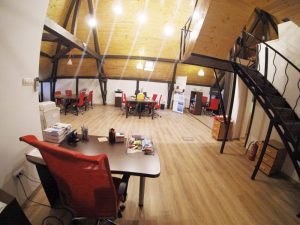Soluții sustenabile
pentru afacerea ta
#BE GREEN

Gestionarea amprentei de carbon este esențială pentru companiile care doresc să adopte practici sustenabile. Aceasta reprezintă nu doar o obligație legală, ci și o oportunitate de a proteja mediul, de a atrage clienți responsabili și de a respecta reglementările în continuă evoluție. Printr-un plan bine structurat, impactul ecologic al organizației tale poate fi redus semnificativ.
La Centrul de Dezvoltare SMART, îți oferim sprijin complet pentru a evalua și diminua impactul ecologic. După identificarea surselor principale de emisii, dezvoltăm strategii eficiente care contribuie la respectarea standardelor internaționale ISO 14064 și ISO 14067. Astfel, fiecare pas devine o investiție sigură în viitorul organizației tale.
Cum să beneficiezi de servicii de optimizare a amprentei CO2?
Adoptarea unor practici sustenabile contribuie la respectarea reglementărilor, reducerea costurilor și protecția mediului. Lucrează alături de experții noștri pentru a dezvolta strategii eficiente și conforme standardelor internaționale.
Completează formularul pentru a solicita o ofertă personalizată și descoperă cum putem sprijini afacerea ta să devină mai verde și mai competitivă!
Servicii oferite

Îți punem la dispoziție soluții complete pentru gestionarea amprentei de carbon, incluzând măsurarea emisiilor, elaborarea strategiilor de reducere și certificarea conform standardelor internaționale.



Evaluare amprentă CO2
Primul pas în gestionarea impactului asupra mediului este măsurarea precisă a emisiilor de gaze cu efect de seră. Analizăm activitățile organizației tale pentru a identifica sursele principale de emisii. Ulterior, calculăm aceste emisii conform standardelor internaționale și furnizăm un raport detaliat care evidențiază zonele ce necesită îmbunătățiri.
Strategii reducere emisii
Planificarea sustenabilă începe cu stabilirea unor obiective clare. Propunem soluții personalizate precum utilizarea surselor de energie regenerabilă, optimizarea proceselor interne și alte măsuri inovatoare. Prin aplicarea acestor strategii, costurile operaționale sunt optimizate, iar impactul asupra mediului este redus.
Certificare și instruire
Recunoașterea eforturilor organizației tale prin certificare oferă credibilitate și încredere. Implementăm sisteme de management conform standardelor ISO și colaborăm cu organisme internaționale de certificare. Totodată, livrăm training-uri adaptate pentru echipele tale, pregătindu-le pentru provocările sustenabilității.

Evaluare amprentă CO2
Primul pas în gestionarea impactului asupra mediului este măsurarea precisă a emisiilor de gaze cu efect de seră. Analizăm activitățile organizației tale pentru a identifica sursele principale de emisii. Ulterior, calculăm aceste emisii conform standardelor internaționale și furnizăm un raport detaliat care evidențiază zonele ce necesită îmbunătățiri.

Strategii reducere emisii
Planificarea sustenabilă începe cu stabilirea unor obiective clare. Propunem soluții personalizate precum utilizarea surselor de energie regenerabilă, optimizarea proceselor interne și alte măsuri inovatoare. Prin aplicarea acestor strategii, costurile operaționale sunt optimizate, iar impactul asupra mediului este redus.

Certificare și instruire
Recunoașterea eforturilor organizației tale prin certificare oferă credibilitate și încredere. Implementăm sisteme de management conform standardelor ISO și colaborăm cu organisme internaționale de certificare. Totodată, livrăm training-uri adaptate pentru echipele tale, pregătindu-le pentru provocările sustenabilității.
Avantaje și beneficii
Gestionarea emisiilor de gaze cu efect de seră nu este doar o cerință legală, ci și o oportunitate strategică. Beneficiile includ:
Optimizarea consumului de energie și reducerea deșeurilor îți scad cheltuielile pe termen lung.
Consumatorii apreciază brandurile sustenabile, ceea ce crește loialitatea și atrage noi clienți.
Alinierea la standardele ecologice deschide oportunități internaționale și parteneriate strategice.
Evită sancțiunile prin conformarea cu normele naționale și europene.
Profită de granturi, subvenții și alte stimulente pentru companiile sustenabile.
Directive și reglementări
Uniunea Europeană și alte organisme internaționale au stabilit standarde stricte pentru reducerea amprentei de carbon. Iată principalele directive:
Obligă companiile să dezvăluie impactul lor ecologic, inclusiv emisiile de GES.
Obiectivul de neutralitate climatică până în 2050 devine o obligație legală.
Impune achiziționarea de permise pentru fiecare tonă de CO₂ emisă.
Asigură că activitățile economice sunt sustenabile și conforme standardelor ecologice.
Vizează atingerea zero emisii nete conform obiectivelor naționale și europene.
De ce să alegi Centrul de Dezvoltare SMART pentru gestionarea amprentei de carbon?

Sustenabilitatea devine un standard esențial pentru orice afacere modernă. Noi suntem aici să te ajutăm să îți transformi obiectivele ecologice în rezultate concrete.
Experții noștri sunt specializați în standardele ISO 14064 și ISO 14067, garantând servicii de înaltă calitate.
Oferim soluții adaptate specificului organizației tale, de la identificarea emisiilor, până la dezvoltarea de strategii eficiente de reducere.
De la calculul amprentei de carbon și implementarea strategiilor, până la certificare și instruirea echipei tale, acoperim fiecare etapă a procesului.
Cu Centrul de Dezvoltare SMART, sustenabilitatea devine mai mult decât o obligație – devine o oportunitate de a-ți consolida poziția pe piață.
Transformă amprenta de carbon a afacerii tale într-un avantaj competitiv.
Ce spun clienții și partenerii noștri



